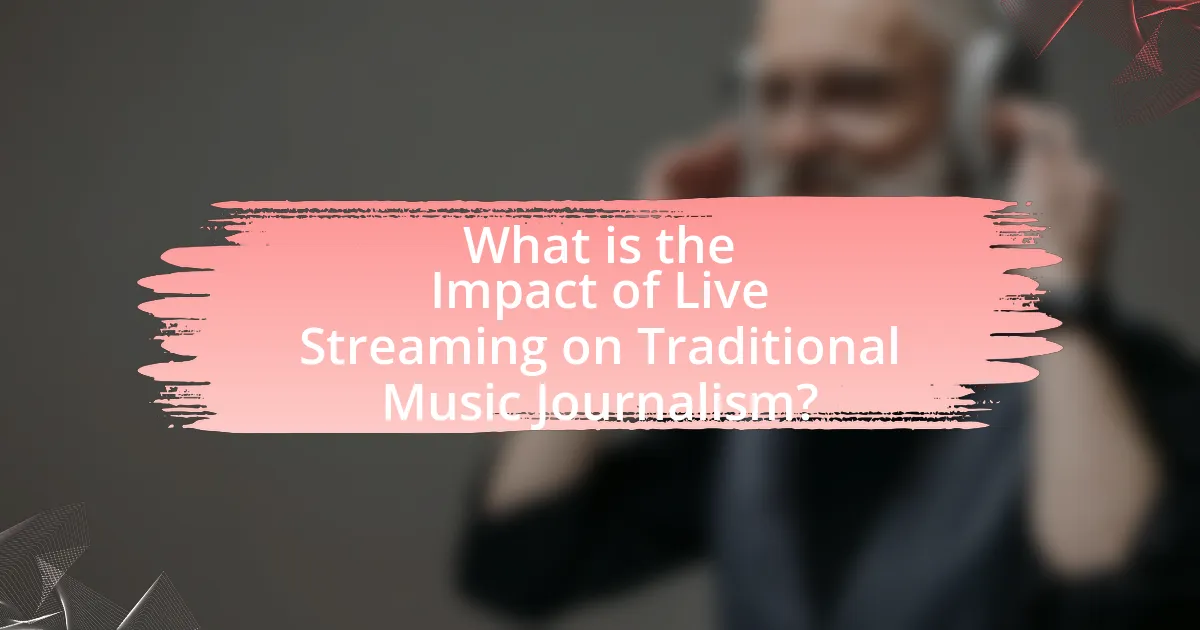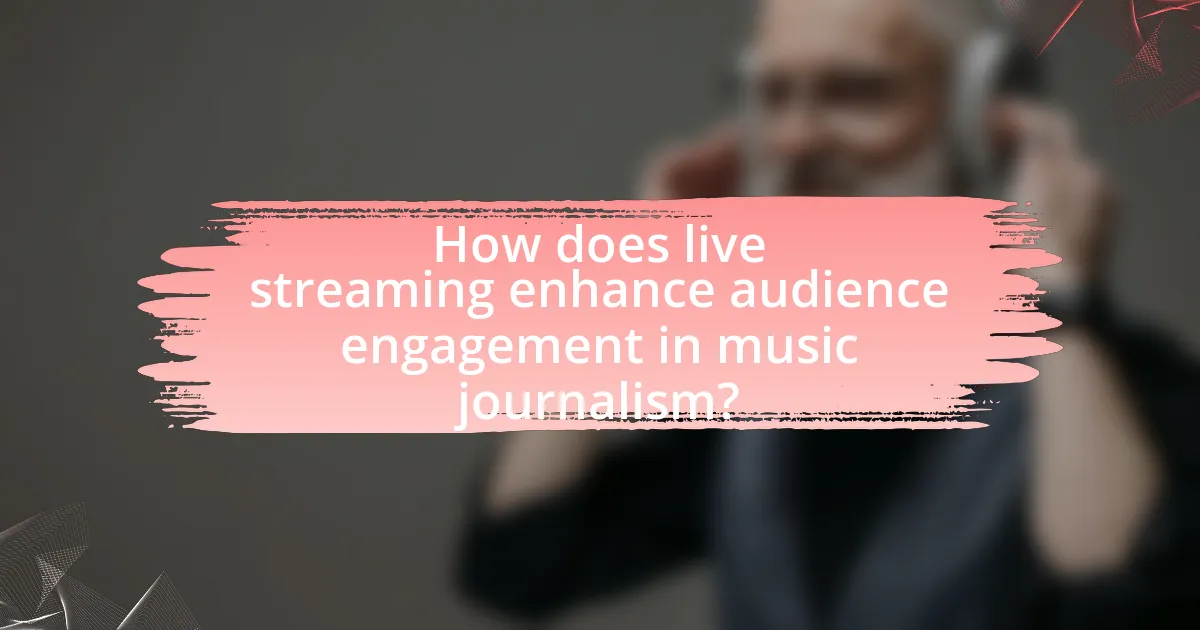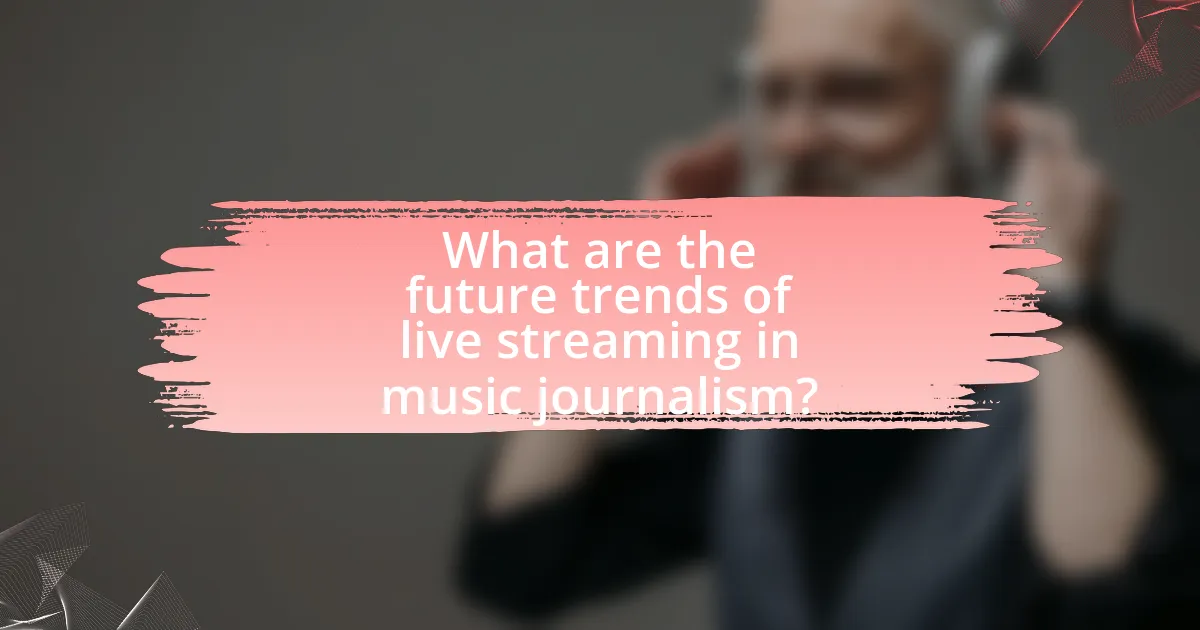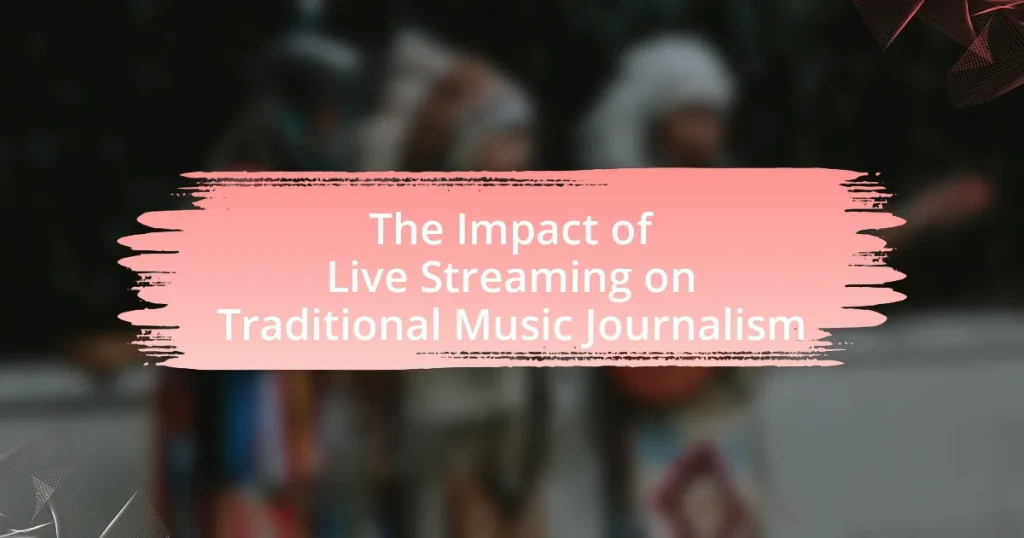The article examines the impact of live streaming on traditional music journalism, highlighting a significant shift from written content to real-time audience engagement and multimedia experiences. It discusses how platforms like Twitch and YouTube facilitate direct artist-fan interactions, challenging the relevance and revenue of traditional journalism. Key features of live streaming, such as immediacy and accessibility, are explored, along with the implications for music journalists in adapting to this evolving landscape. The article also addresses the challenges faced by traditional media outlets and the future trends of live streaming in enhancing audience engagement and content promotion.

What is the Impact of Live Streaming on Traditional Music Journalism?
Live streaming significantly alters traditional music journalism by shifting the focus from written reviews and interviews to real-time audience engagement and multimedia content. This transformation allows artists to connect directly with fans, diminishing the role of journalists as intermediaries. For instance, platforms like Twitch and YouTube enable musicians to perform live, interact with viewers, and receive immediate feedback, which can lead to a more dynamic and participatory experience. Consequently, traditional music journalism faces challenges in relevance and revenue, as audiences increasingly prefer direct artist communication over mediated content.
How has live streaming changed the landscape of music journalism?
Live streaming has transformed music journalism by enabling real-time coverage and direct artist-audience interaction. This shift allows journalists to provide immediate insights and updates during live events, enhancing the immediacy and relevance of their reporting. For instance, platforms like Instagram Live and Twitch have become essential tools for journalists, allowing them to broadcast interviews, performances, and behind-the-scenes content instantly. According to a 2021 report by the International Federation of the Phonographic Industry, 40% of music fans engage with live-streamed content, indicating a significant shift in how audiences consume music-related news. This trend has led to a more dynamic and participatory form of journalism, where traditional articles are supplemented or replaced by live video content, fostering a closer connection between artists and their fans.
What are the key features of live streaming that influence music journalism?
The key features of live streaming that influence music journalism include real-time audience engagement, accessibility, and the ability to showcase performances directly from artists. Real-time audience engagement allows journalists to interact with fans and gather immediate feedback, enhancing the coverage of events. Accessibility enables a broader audience to experience live performances, which can lead to increased visibility for artists and more diverse content for journalists. Additionally, showcasing performances directly from artists provides authentic content that can be analyzed and reported on, offering unique insights into the music scene. These features collectively reshape how music journalism is conducted, emphasizing immediacy and direct artist-fan connections.
How does live streaming alter the way audiences consume music content?
Live streaming significantly alters the way audiences consume music content by providing immediate access to performances and fostering real-time interaction. This shift allows fans to experience concerts and events from anywhere, breaking geographical barriers and increasing audience engagement. According to a report by Nielsen Music, live streaming events saw a 25% increase in viewership in 2020, highlighting the growing preference for digital access over traditional attendance. Additionally, platforms like Twitch and YouTube Live enable artists to connect directly with their audience through chat features, enhancing the communal experience of music consumption.
What challenges does traditional music journalism face due to live streaming?
Traditional music journalism faces significant challenges due to live streaming, primarily in the areas of revenue loss and audience engagement. The rise of live streaming platforms allows artists to connect directly with fans, often bypassing traditional media outlets, which diminishes the relevance of music journalists. According to a report by the International Federation of the Phonographic Industry, streaming accounted for 62% of the global recorded music revenue in 2020, indicating a shift in how audiences consume music. This shift leads to decreased advertising revenue for traditional music journalism, as brands increasingly invest in digital platforms rather than print or online publications. Additionally, the immediacy of live streaming creates a demand for real-time coverage that traditional journalism may struggle to meet, further challenging its role in the music industry.
How does the rise of live streaming platforms affect traditional media outlets?
The rise of live streaming platforms significantly diminishes the audience and revenue of traditional media outlets. As viewers increasingly prefer the immediacy and interactivity of live streaming, traditional media experiences declining viewership and advertising income. For instance, a report by eMarketer in 2021 indicated that U.S. adults spent an average of 1 hour and 16 minutes per day on digital video platforms, including live streaming, compared to just 35 minutes on traditional television. This shift in consumer behavior highlights the competitive disadvantage faced by traditional media, which struggles to adapt to the on-demand nature of live streaming.
What are the implications for music journalists in adapting to live streaming?
Music journalists must embrace live streaming to remain relevant in the evolving media landscape. The shift to live streaming allows journalists to engage audiences in real-time, providing immediate coverage of events and performances, which enhances their storytelling capabilities. According to a 2021 report by the International Federation of the Phonographic Industry, 70% of music consumers prefer live-streamed content, indicating a significant audience demand that journalists must meet. Additionally, adapting to live streaming enables music journalists to diversify their content formats, such as interviews and behind-the-scenes access, which can attract new readership and viewership. This adaptation is essential for maintaining competitive advantage in an industry increasingly driven by digital consumption.

How does live streaming enhance audience engagement in music journalism?
Live streaming enhances audience engagement in music journalism by providing real-time interaction and immersive experiences. This format allows journalists to connect directly with their audience through live Q&A sessions, instant feedback, and the ability to share behind-the-scenes content, fostering a sense of community. According to a study by the Pew Research Center, 54% of live stream viewers reported feeling more connected to the content and creators, indicating that live streaming significantly boosts audience involvement and loyalty in music journalism.
What role does interactivity play in live streaming for music journalism?
Interactivity plays a crucial role in live streaming for music journalism by enhancing audience engagement and fostering real-time communication. This dynamic allows journalists to connect directly with viewers, facilitating immediate feedback and discussions about music events, trends, and artist performances. For instance, platforms like Twitch and YouTube Live enable features such as live chats and polls, which can significantly increase viewer participation and investment in the content being presented. Research indicates that interactive elements in live streaming can lead to higher viewer retention rates, with studies showing that audiences are more likely to stay engaged when they can actively participate in the conversation.
How do live chats and Q&A sessions impact audience participation?
Live chats and Q&A sessions significantly enhance audience participation by fostering real-time interaction and engagement. These formats allow audiences to ask questions, share opinions, and receive immediate feedback, which increases their sense of involvement and investment in the content. Research indicates that interactive elements like live chats can boost viewer retention rates by up to 80%, as participants feel more connected to the event and its hosts. This heightened engagement leads to a more dynamic and participatory experience, ultimately enriching the overall impact of live streaming in contexts such as traditional music journalism.
What are the benefits of real-time feedback for music journalists?
Real-time feedback provides music journalists with immediate insights into audience reactions, enhancing their ability to tailor content effectively. This responsiveness allows journalists to adjust their coverage based on what resonates with their audience, leading to more engaging and relevant articles. Additionally, real-time feedback fosters a sense of community between journalists and their audience, as it encourages interaction and dialogue, which can lead to increased readership and loyalty. Studies have shown that content that reflects audience preferences tends to perform better, indicating that real-time feedback can significantly improve the quality and impact of music journalism.
How does live streaming influence the promotion of music events?
Live streaming significantly enhances the promotion of music events by expanding audience reach and engagement. It allows artists and event organizers to broadcast performances to a global audience, breaking geographical barriers that limit attendance. For instance, a study by the International Music Summit in 2021 indicated that 70% of music fans are more likely to attend a live event after experiencing a live stream of the artist. Additionally, live streaming creates interactive opportunities through real-time audience participation, such as live chats and social media integration, which fosters a sense of community and increases visibility for the event. This dual approach of in-person and online engagement effectively amplifies promotional efforts, leading to higher ticket sales and greater brand awareness for artists and venues.
What strategies do artists use to leverage live streaming for promotion?
Artists leverage live streaming for promotion by engaging directly with their audience, showcasing new material, and creating exclusive content. By utilizing platforms like Instagram Live, Twitch, and YouTube, artists can host virtual concerts, Q&A sessions, and behind-the-scenes glimpses, which fosters a sense of community and immediacy. For instance, a study by the International Federation of the Phonographic Industry (IFPI) in 2021 indicated that 60% of music fans prefer live streaming events as a way to connect with artists. This direct interaction not only enhances fan loyalty but also increases visibility and reach, as viewers often share these experiences on social media, amplifying promotional efforts.
How do live streaming events compare to traditional promotional methods?
Live streaming events offer a more interactive and immediate promotional method compared to traditional promotional methods, which often rely on static content like print ads or pre-recorded videos. Live streaming allows real-time engagement with audiences, fostering a sense of community and urgency that traditional methods lack. For instance, a study by Livestream and New York Magazine found that 80% of audiences prefer live video over traditional social media posts, highlighting the effectiveness of live streaming in capturing attention and driving engagement. Additionally, live streaming can reach a global audience instantly, whereas traditional methods are often limited by geographic and temporal constraints.

What are the future trends of live streaming in music journalism?
The future trends of live streaming in music journalism include increased interactivity, enhanced audience engagement, and the integration of virtual reality experiences. As platforms evolve, journalists will leverage live streaming to create real-time interactions with audiences, allowing for Q&A sessions and live feedback during performances. Additionally, the rise of immersive technologies, such as virtual reality, will enable music journalists to offer unique experiences, such as virtual concerts or behind-the-scenes access, which can attract larger audiences. According to a report by eMarketer, live streaming is projected to grow significantly, with an expected increase in user engagement and content consumption, indicating that music journalism will increasingly adopt these technologies to stay relevant and connect with audiences effectively.
How might technology advancements shape live streaming in music journalism?
Technology advancements will significantly enhance live streaming in music journalism by improving accessibility, interactivity, and content quality. Enhanced internet speeds and streaming platforms enable journalists to broadcast live events in high definition, allowing audiences to experience concerts and interviews in real-time. For instance, the rise of 5G technology facilitates seamless streaming without buffering, which is crucial for maintaining viewer engagement. Additionally, advancements in augmented reality (AR) and virtual reality (VR) can create immersive experiences, allowing audiences to feel as though they are part of the event. According to a report by Statista, the global live streaming market is projected to reach $247 billion by 2027, indicating a growing trend that music journalists can leverage to reach wider audiences and create more dynamic content.
What emerging technologies could enhance live streaming experiences?
Emerging technologies that could enhance live streaming experiences include augmented reality (AR), virtual reality (VR), and artificial intelligence (AI). AR can overlay digital information onto the real world, creating immersive environments for viewers, while VR can transport users into fully interactive virtual spaces, enhancing engagement during live events. AI can optimize streaming quality by adjusting bandwidth in real-time and providing personalized content recommendations based on viewer preferences. These technologies are supported by advancements in 5G connectivity, which allows for higher data transfer rates and lower latency, further improving the overall streaming experience.
How will audience expectations evolve with advancements in live streaming?
Audience expectations will evolve to demand higher quality, interactivity, and personalization in live streaming experiences. As technology advances, viewers will expect seamless streaming with minimal latency, high-definition visuals, and immersive audio, reflecting the standards set by platforms like Netflix and YouTube. Additionally, audiences will increasingly seek interactive features such as real-time engagement through chats, polls, and augmented reality elements, which enhance their connection to the content and creators. This shift is supported by data indicating that 80% of consumers prefer live video over traditional social media posts, highlighting a growing desire for authentic and engaging experiences. Consequently, traditional music journalism must adapt to these evolving expectations by integrating advanced streaming technologies and interactive formats to remain relevant and appealing to audiences.
What best practices should music journalists adopt for live streaming?
Music journalists should adopt several best practices for live streaming to enhance their coverage and audience engagement. First, they must ensure high-quality audio and video to provide a professional viewing experience, as poor quality can deter viewers and diminish credibility. Second, engaging with the audience through real-time interaction, such as responding to comments and questions, fosters a sense of community and keeps viewers invested. Third, promoting the live stream in advance across various platforms increases visibility and attendance, as studies show that pre-event marketing can significantly boost viewer numbers. Additionally, journalists should incorporate storytelling elements to create a narrative around the live stream, making the content more compelling and relatable. Finally, analyzing viewer feedback and metrics post-stream helps journalists refine their approach for future events, ensuring continuous improvement in their live streaming efforts.
How can journalists effectively integrate live streaming into their reporting?
Journalists can effectively integrate live streaming into their reporting by utilizing real-time engagement with audiences during events, interviews, or breaking news. This approach allows journalists to provide immediate updates and insights, fostering a direct connection with viewers. For instance, during a live concert, journalists can stream performances, conduct interviews with artists, and share audience reactions, enhancing the storytelling experience. Research indicates that live streaming increases viewer retention and interaction, with platforms like Facebook Live reporting that live videos receive 3 times more engagement than pre-recorded content. By leveraging these capabilities, journalists can enhance their reporting and adapt to the evolving media landscape.
What tips can enhance the quality of live streaming content for music journalism?
To enhance the quality of live streaming content for music journalism, focus on high-quality audio and video production. High-quality audio is crucial because poor sound can detract from the viewer’s experience; studies show that 70% of viewers will abandon a stream if the audio is subpar. Additionally, engaging visuals, such as well-framed shots and appropriate lighting, can significantly improve viewer retention and engagement. Incorporating interactive elements, like live Q&A sessions or polls, can also foster audience participation, making the content more dynamic and appealing. Furthermore, consistent branding and a clear narrative structure help maintain professionalism and coherence, which are essential for building a loyal audience.


